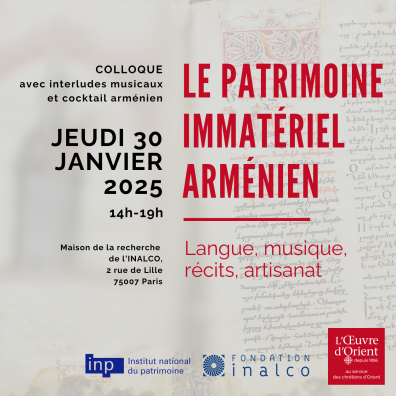Armenian intangible heritage - Language, music, stories, crafts

The Armenian cultural heritage, rich in history spanning thousands of years and spread throughout the world by the diaspora, has been the object of numerous attempts at destruction and uprooting throughout history. After the erasure of Armenian heritage in the Nakhchivan region, history is repeating itself with Nagorno-Karabakh: deprived of their historic homeland, the Armenians of Nagorno-Karabakh are challenged to ensure the continuity of their collective identity. At the same time, a policy of erasing Armenian culture and reappropriating it is being pursued in the conquered region.
In particular, intangible heritage is a veritable living memory, constitutive of the identity of peoples. It is directly impacted by the conflicts that threaten Armenia and the ruptures between generations caused by these geopolitical recompositions. Passing it on and preserving it means keeping the soul of the Armenian people alive.
In presence of H.E.Mr. Arman Khachatryan,
With the participation of:
- Philippe Advani, President of the Inalco Foundation
- Anaïd Donabédian-Demopoulos, Linguist and Director of the Armenian Section at Inalco
- Monseigneur Pascal Gollnisch, Director of L'Œuvre d'Orient
- Anna Leyloyan-Yekmalyan, Senior Lecturer
- Astrigh Marabyan, Director of the Department of Cultural Heritage at the Ministry of Culture of the Republic of Armenia
- Michel Petrossian, Composer, writer and historian
- Philippe Sukiasyan, Historian and deacon of the Armenian Apostolic Church
The symposium will take place in three parts, three round-table discussions, interspersed with musical interludes. It will close with an Armenian cocktail.
- 1st round-table: What are the specificities and riches of Armenian intangible heritage and how does it contribute to the influence of Armenian culture?
- 2nd round-table: Players in safeguarding Armenian cultural heritage: how can Armenian intangible heritage be safeguarded and transmitted today? How can a forcibly displaced people continue to express its cultural identity even when it is under threat? How do creation and transmission fit together? Confrontation of several visions and examples with the presence of associative, national and international actors.
- 3rd round table: Armenian identity through language and spirituality: through language and liturgy, how can we understand the issues of transmission, identity and spirituality that are at stake in this heritage?